
The Lizzie Campbell
Research and writing by Verlyn Mayer
Map of Nebraska City circa 1868 showing the ferry landing on the far left side of the picture. Note the buildings in the lower left edge of the picture. This would be Eastport, Iowa.
The first ferry was established at Nebraska City as early as 1848, by a Col. John Boulware and managed by him and sons for some years. John B. Boulware built a ferry house in 1852 and the first permanent habitation on the town site on the river bank at the foot of Commercial Street.
The first steam ferry boat, the Nebraska, was brought to Nebraska City in May, 1854 and owned by William and Kennett McLennan. The next was the Comet brought from Ohio in 1857.
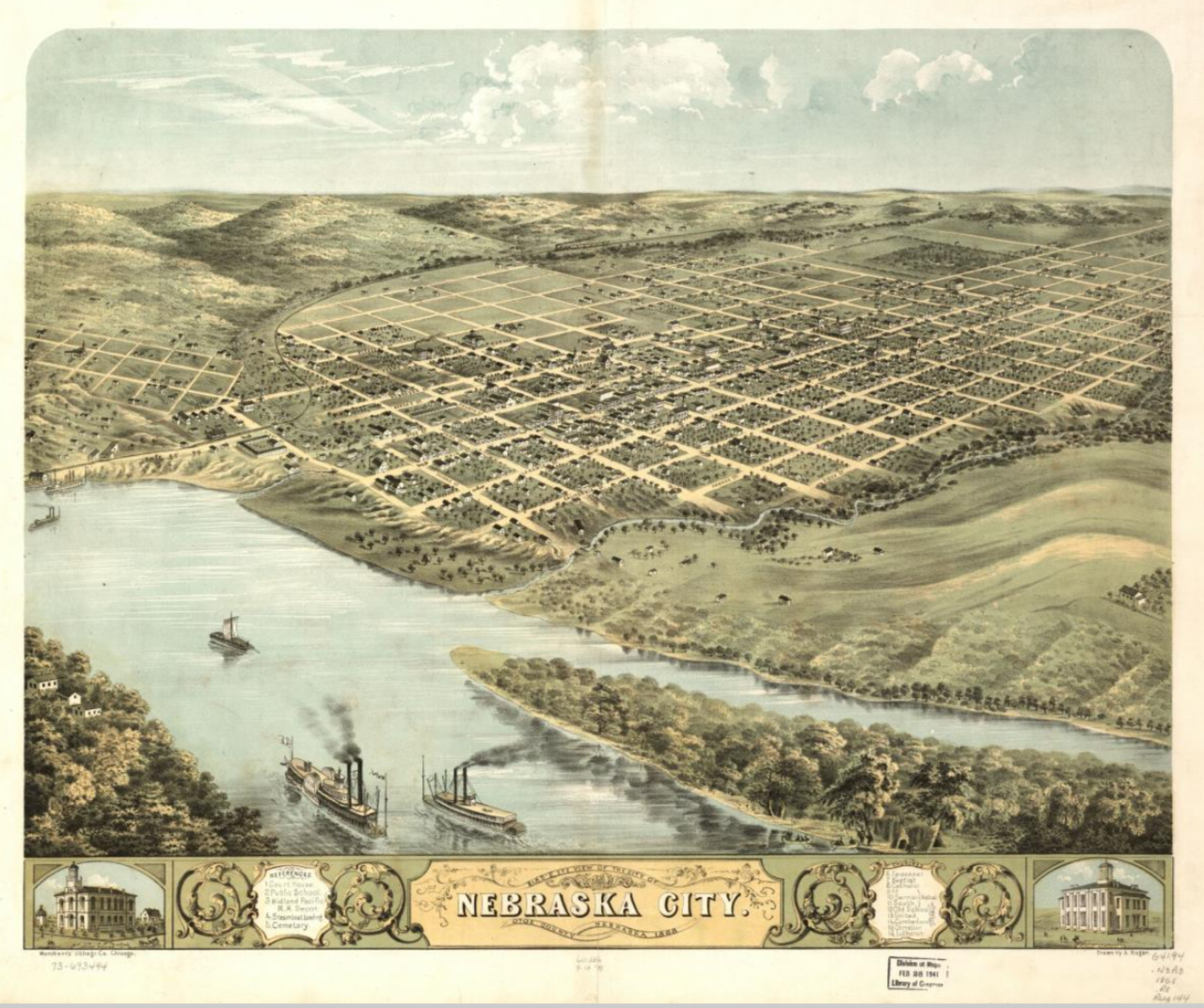
After the Civil War a company named Nebraska Transfer Company owned by William Payne, G. T. Lincoln and T. K. Bradley began operating ferry boats in 1869 under a charter at Nebraska City.
The Lizzie Campbell was a stern-wheel ferry built around 1868 in Jeffersonville, Indiana. It became either the first or among the first ferries to be operated by the newly formed transfer company. At the time the Lizzie Campbell was a modern ferry described as being large enough to carry thirty teams of horses, mules or oxen.
The reason I researched and have written this about the Nebraska City ferries is because sometime around 1870 two brothers arrived in the area named Frank David Lemon and his brother John Eugene. John was my 2nd Great-Grandfather.
Frank and John moved there along with Aunts, Uncles and Cousins from their mother's side of the family. Frank and some of his cousins lived in Eastport, Iowa on the opposite side of the Missouri River and went to work for the Nebraska Transfer Company while John moved into Nebraska City and became a farm implement mechanic.
The following news clipping tells of when the new ferry boat Lizzie Campbell left for the Missouri River:
(The Cincinnati Enquirer (Cincinnati, Ohio) · Tue, Apr 21, 1868 · Page 3)
The most likely route the boat took to arrive on the Missouri River was to follow the Ohio River west to the Mississippi River. Then proceed north to the mouth of the Missouri River and then up river to Nebraska City. The trip was estimated to take four weeks for when the James F. Joy was brought to Nebraska City.
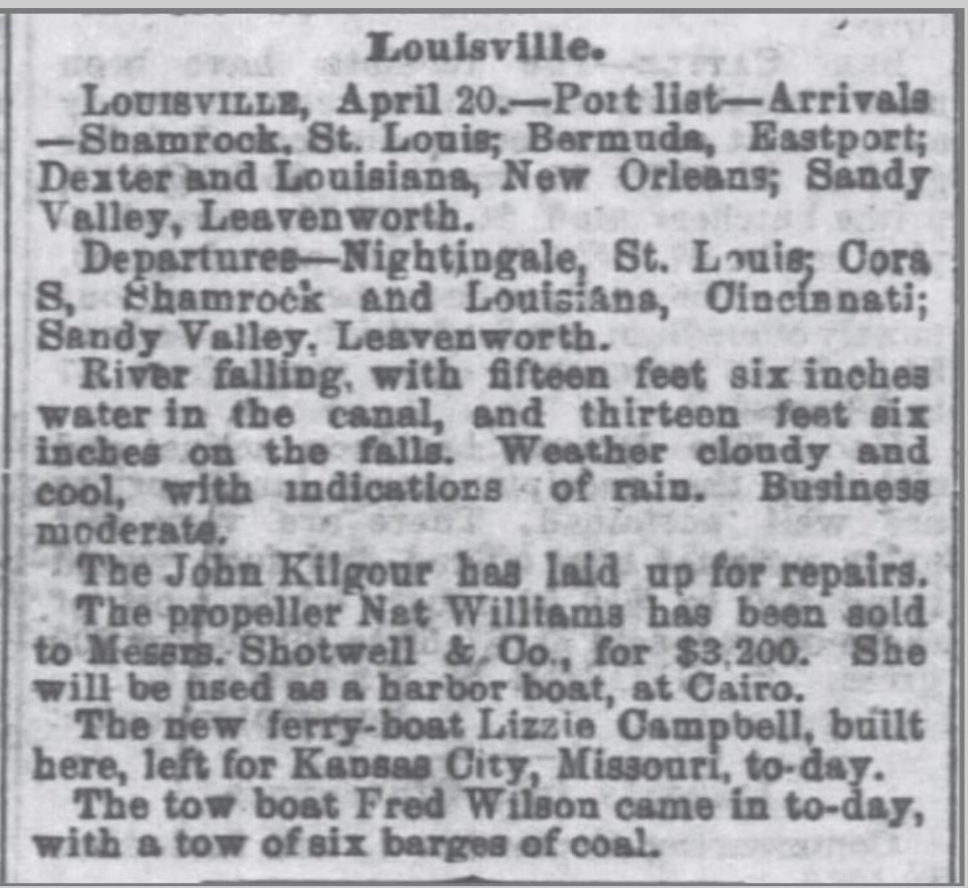
Jeffersonville is located on the Ohio River. The date the Lizzie Campbell arrived on the Missouri River is not known. From the next news clip, published by a Kansas City, Missouri newspaper on June 30, 1869, it was by then on the Missouri River:
Terre-Haute Weekly Express,Terre Haute, Vigo County, 30 June 1869 Page 4 Note, Harlem was the former name for Kansas City, Missouri before it was changed to Kansas City in 1889.
From this clipping one can see the Lizzie Campbell appears to have its moments of excitement.
Before he died in 1933 Edgar Luke, a former crewman aboard the Lizze Campbell, wrote of an experience he had highlighted in yellow in the next clipping.
Luke was a relative of mine, a first cousin of Frank and John Lemon. Luke worked for the ferry company throughout the 1870s - a period of around ten years.
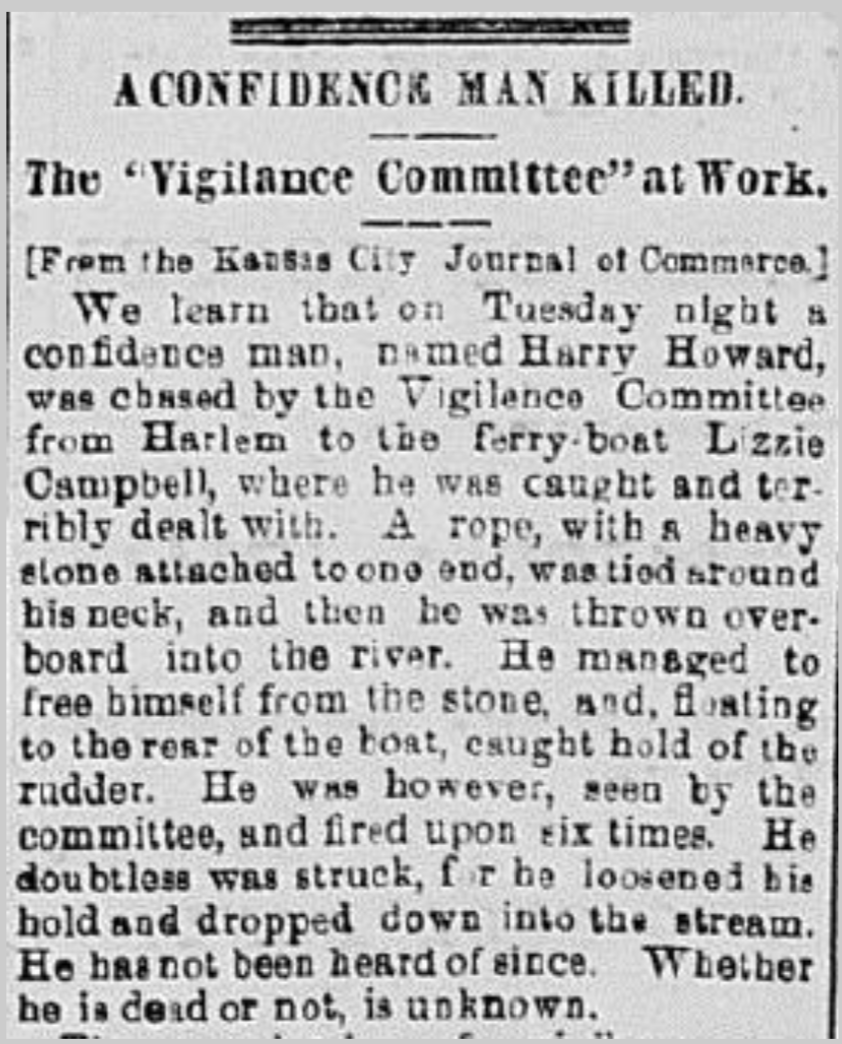
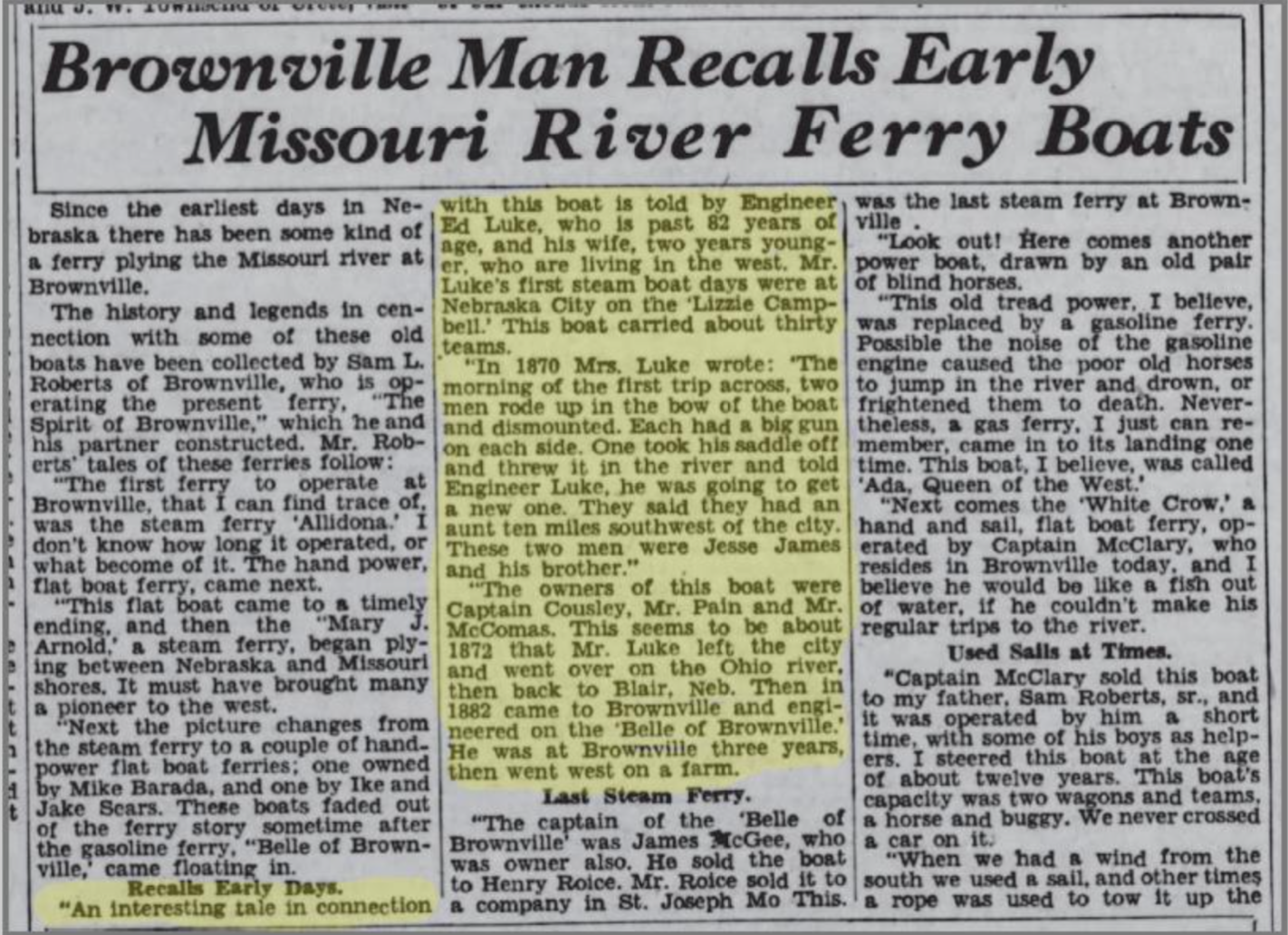
The Lincoln Star (Lincoln, Nebraska) · Sun, Oct 16, 1932 · Page 28
Undoubtedly Luke could tell many stories, but to him this experience was special since it involved direct contact with Jesse James who by then was publicly labeled an "outlaw" by having Missouri Governor Thomas T. Crittenden set a reward for his capture.
Where the article says that "about 1872 that Mr. Luke left the city and went over on the Ohio River" likely means he may have taken part in the delivery of the new ferryboat James F. Joy.
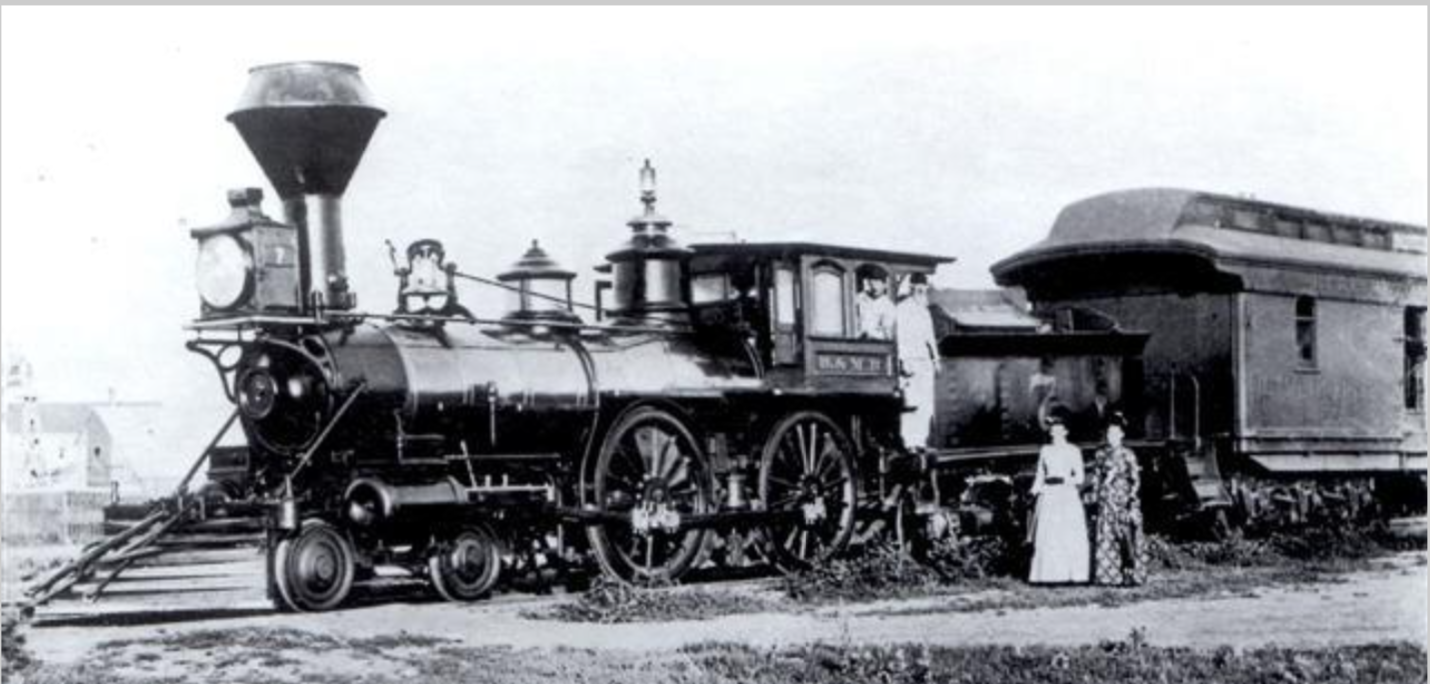
Manufactured by Manchester Locomotive Works of Manchester, New Hampshire in 1870 and known as the "Wauhoo," Burlington & Missouri Railroad's (B & MR) 4-4-0 locomotive was the 1st train that served Ashland, Nebraska. This picture represents what railroad trains looked like in Nebraska and Iowa during the 1870s.
1870 marked the advent of the railroad which had been brought to Fremont County, Iowa during the last half of the 1860s. The Lizzie Campbell lacked the ability to ferry trains across the Missouri River. So, another more powerful ferryboat was brought in.
Artistic depiction from an 1880 painting by Aug Koch, the only known depiction of the ferryboat.
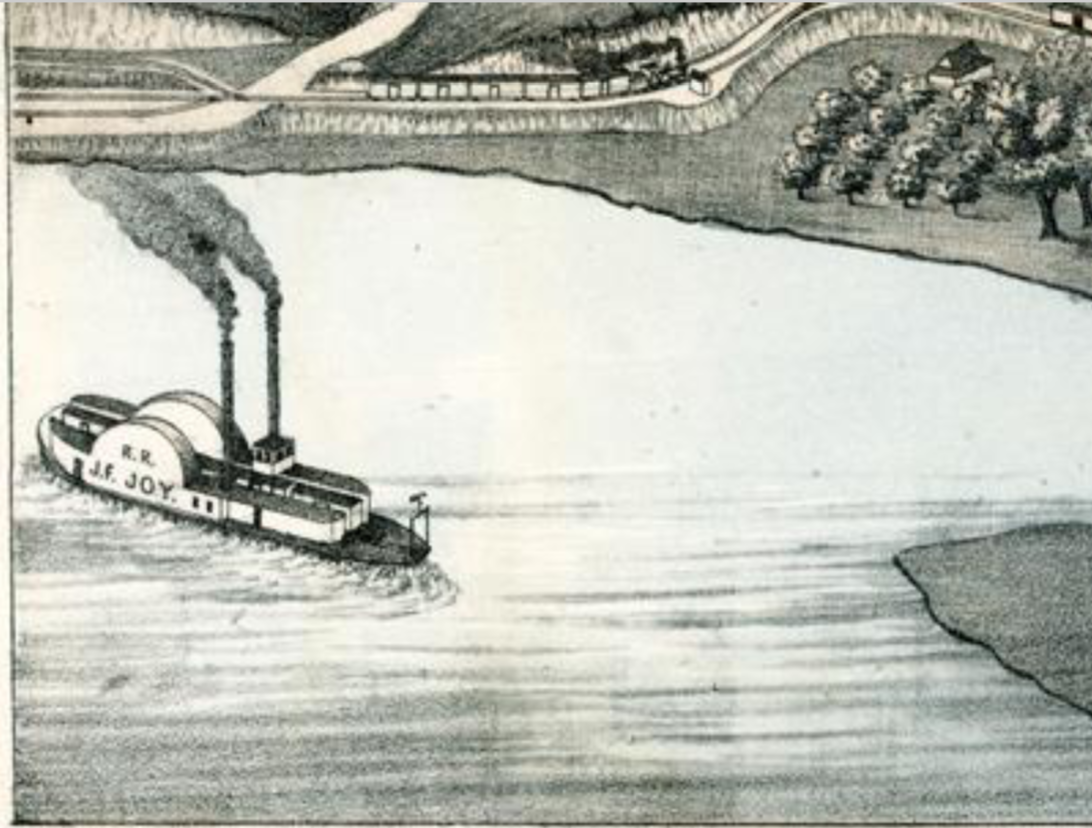
On March 15, 1873, the Nebraska City News reported that their new transfer boat would be named J. F. JOY in honor of late railroad king of the Missouri Valley. The ferry boat was being built in Madison, Indiana, was 150 foot long, a side-wheeler with a 1500 horse power engine for each wheel; a railroad track would run from end to end, and that it could carry two passenger cars or four freight cars at one time.
A series of news articles from the Nebraska City News describes the James F. Joy's first year of operation:
--- May 24, 1873
"CAPT. SOUSLEY RETURNED.
Crew for Transfer Boat Starts Tomorrow":
"Capt. Sousley returned home from Madison, Indiana, on Saturday. The transfer boat is nearly completed, having been delayed several weeks beyond her contract time by bad weather.
"But the crew is engaged, and will start tomorrow for Madison, to take charge of the new craft. Billy Richmond, the old stand by engineer of the ferry boat, goes to take charge of her machinery and steam works. John Beebout, assistant engineer, Ross Liston and Dick Johnson go as assistant pilots. Sherman Hoyt, Ellis Griffin and Nels. Nelson make up the balance of the crew. Mr. Nelson is a Dane, and an old sailor who "knows the ropes" like a-b- c. Captain Sousley himself, of course will boss the job and pilot her into port. He will have to hire an Ohio river pilot to bring her down to Cairo, as he has no license for that river; but from Cairo to Nebraska City he can "paddle his own canoe."
"It is expected that the crew will have about a week's work to complete the boat's rigging and fixtures, testing her machinery, &c, before starting on the homeward trip. And over a hundred tons of freight are already engaged to be brought up by her.
"If no further mishaps or extraordinary hindrances occur, in four weeks from this time the boat will be here whisking loaded cars back and forth across the river. And our citizens will all wish Capt. Sousley and his crew a jolly trip and safe return."
Note; Capt. J R Sousley came to Nebraska City in the fall of 1868 and bought a quarter interest in the transfer company. The transfer company operated the boat for eight years, when it was sold to the Burlington & Missouri River Railroad, in Nebraska.
July 26, 1873. 3 - 1.
"Capt. Sousley's Pontoon Bridge. THE HISTORIC TRAIN.
First Transfer of Cars To-Day". -- At 4 o'clock this afternoon the K. C., St. Joe & C. B. R. R. Co.'s box cars Nos. 1076 1480, 674 and 824 were run on the Transfer Boat, JAMES F. JOY and crossed over and landed safely without a break or a hitch of any sort. Everything worked beautifully; and now we are ready to cross without breaking bulk all the R. R. freights to and from the whole South Platte region. Send on your produce this way neighbors.
The first train to cross was two empty cars for the Elevator Company and two for Asa Strain, to be loaded with wheat for St. Louis. But there were between forty and fifty cars waiting in East Nebraska City to come over, and they will be hoisted over rapidly.
The Transfer Boat was here, ready for business thirty one days before the tracks were ready; but the St. Joe company has had to grade and drive piling and lay track the third time, on account of the washing by highwater, and have got ready as soon as it was possible to do so.
The boat carries four cars, and half a car length to spare.....The first trip was witnessed by a crowd of citizens; but hundreds more would have been there if they could have known just when to go down. Among the distinguished citizens present to see this great historic even, we noticed George Boulware, Lou Davenport, William B. Hail, E. Humphrey, R. F. McComas, William Payne, Milt Pinney, N. R. Pinney, William Rotton, Ed Sheldon, Ed Smith, Sam Tate, and a great crowd more, too numerous to mention. Capt. Sousley stood at the helm and Billy Richmond at the engine; everything was in tip-top order and worked to a charm.
HURRAH for the Transfer! Fetch on you car loads of stuff, a hundred a day, and they'll switch them across the Big Water with safety and dispatch.
---
July 26, 1873.
3 - 1. About 40 cars were transferred today. If four cars of freight for Lincoln or Seward should arrive on the other side of the river, it would only take 20 minutes to get them over and send them whisling on to their destination.
---
Nov. 15, 1873.
"104 Cars a Day". -- Last spring when we were claiming that our new Transfer boat would be capable of crossing 100 cars a day some of our State contemporaries and some slow folks in our city and vicinity thought we were blowing a ram's horn for Jericho. But we are happy to report that one day last week our Transfer boat "J. F. JOY" crossed 104 cars; another day she crosssd 70; another day 72; and so on. How's that for business?
It is the intention of the company to keep the Transfer passage open all winter, no matter how thick the ice freezes; and there will probably not be more than one day at a time any time during the season that cars cannot be crossed.
---
Dec. 6, 1873. 3 - 5.
--
The river closed above and below the city on Wednesday night. But the transfer and ferry boats (Nebraska City had a second steam ferry -- the LIZZIE CAMPBELL-- which catered to other kinds of travel crossing the river. --W.F.) have kept their own water course open, and there is no interruption of freighting or travel. The car transfer line will be kept open all winter no matter how hard a freeze comes. The good boat J.F. JOY, has her hull built of four inch planks; and then with iron sheeting and chain drags at her bow, and 1,500 horse power at her engines, she plows through the ice and laughs at the furious wind like an iron-clad whale from the great north polar sea.
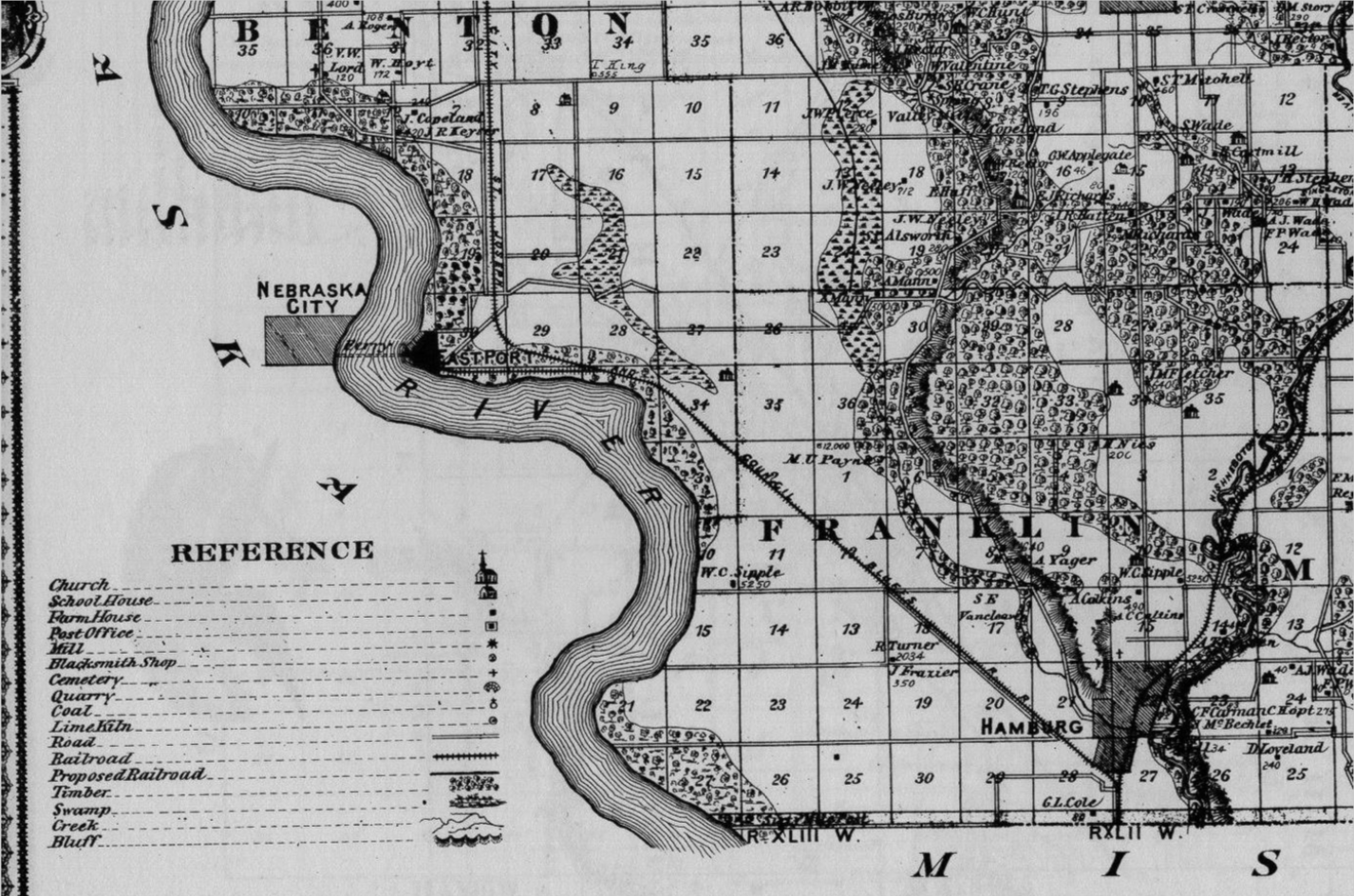
Part of an 1875 map of Fremont County, Iowa that shows the rail line stretching from the Missouri border to Eastport and the ferry line across the Missouri River to Nebraska City.
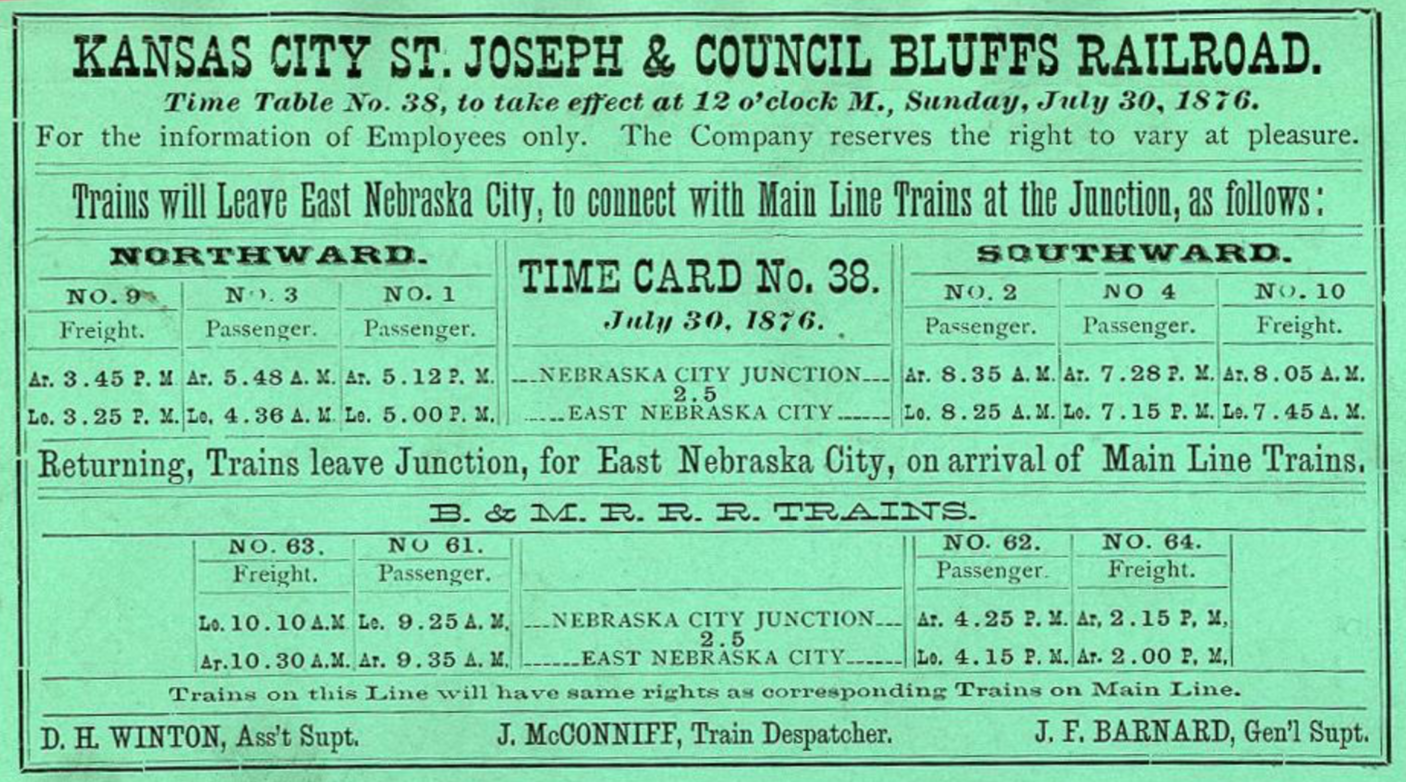
The difference between Nebraska City Junction and East Nebraska City is East Nebraska City is the area in Iowa opposite of Nebraska City that included the town of Eastport. B. & M. R. R. R. refers to a railroad company by the name of Burlington & Missouri River Railroad.
There are few accounts of what the Lizzie Campbell was like. One account is from the Diary of Ada Colvin, June, 1879, in Covered Wagon Women: Diaries & Letters from the Western Trails, vol. 11: 1879-1903. Colvin crossed the Missouri River on the Lizzie Campbell.
Colvin describes the Lizzie Campbell as,
"After waiting a long time we went on the boat that carried us across the river. And the first thing that met my gase, on entering the cabin was, No writeing allowed on this boat. Please take notice of the e in writing for that is the way it was spelled. The name of the boat was Lizzie Campbell but it wasn't nice one bit. I wouldn't have any one name such a looking boat after me; But it took us across the river all safe."
Colvin's description of the Lizzie Campbell makes the boat appear to have been somewhat tattered having been in service for several years.
A second description of the Lizzie Campbell was found in an 1880 publication of Forestry: A Journal of Forest and Estate Management, Volume 3. The book contains a report titled, A Forester on His Travels. The report author crossed the Missouri River on the Lizzie Campbell and described the boat like this:
"By and by a large unshapely steamboat came up, called the Lizzie Campbell, with a flat bottom, and oval shape; owing to the strong current running at the time she had great difficulty in making the landing. All the fires on board burned nothing but wood, but I cannot say how many cords it took to last one month, my note-book being in a soiled state, owing to the rain."
The following map of Nebraska City is from 1880 and shows the James F Joy, the picture I have cameoed above. This would have been the period representing the height of operation for the riverboat ferries at Nebraska City.
Note the street highlighted in red. This is Ferry St., the street John Lemon was said to have been living on for the June 1, 1880 census. He lived in the first ward which extended from the river to Fifth St. (the crossroad highlighted in green).
Both ferries were in service at the time of the Great 1881 Flood. The historical account of the flood comes from a series of articles that appeared in the Nebraska City News-Press:
April 4, 1881.
"The river at this point has been steadily but slowly rising for the past 24 hours. The ice is running today but it is light mush ice so the boats manage to cross (between Nebraska and Iowa) without a great deal of trouble."
April 7, 1881:
"The river is coming up...over 100 men and boys were along the banks catching driftwood...people on the east bank moved to the bluffs."
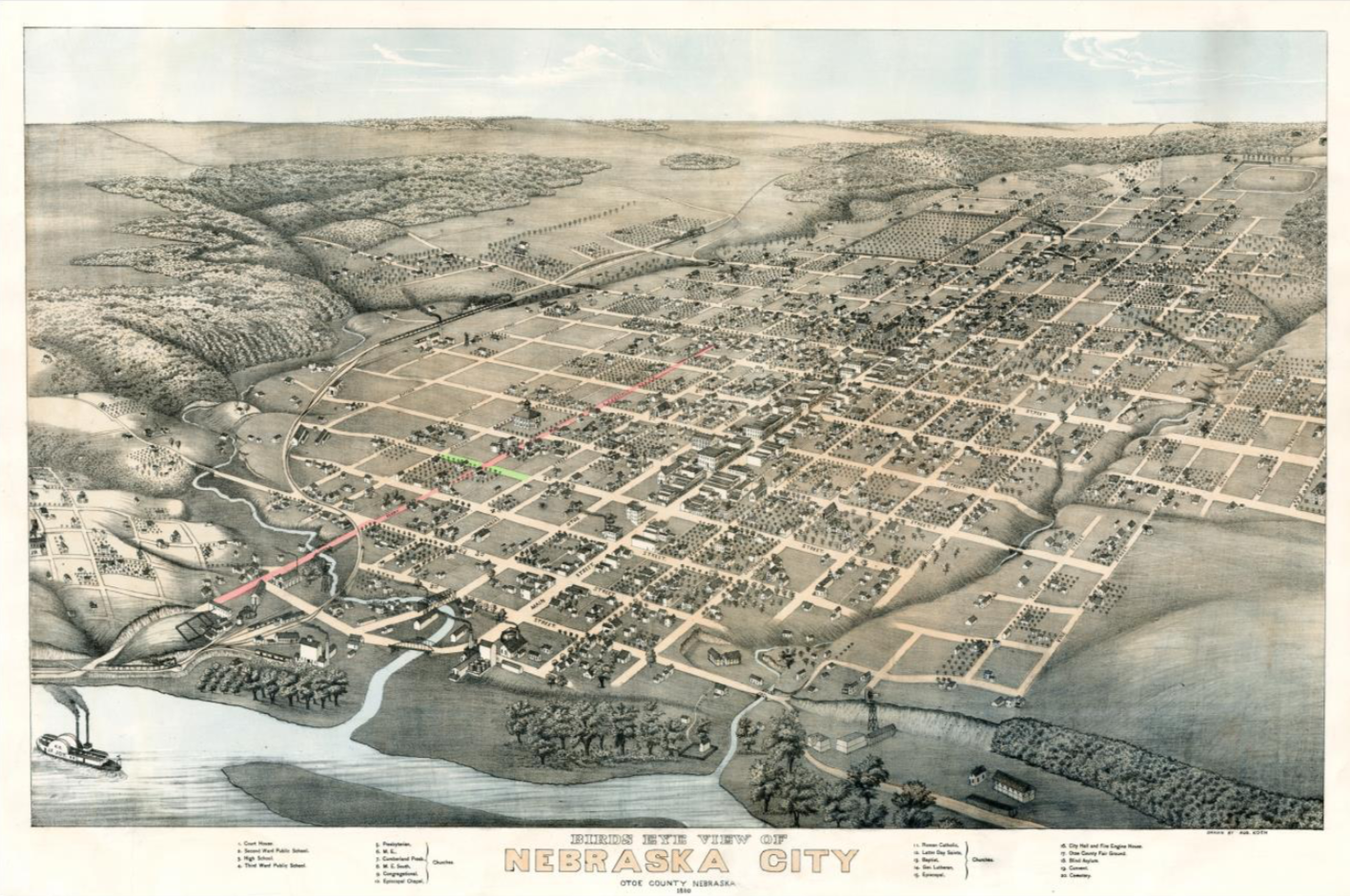
April 8:
"The bottoms on both sides of the river were under water. The steamer C.K. Peck that had departed for Fort Benton, MT, was unreported. Farms owned by Daniel Gregg were fast being washed away."
April 9:
"Passengers brought to Nebraska City by the steamboat Lizzie Campbell were unloaded only by cart as the water ran deep on the landing. Fifty men worked at M. U. Paynes farm on the Iowa bottom to repair a broken dyke. The brickyard of Prue, Driscoll and Co. was entirely submerged."
April 11:
"A news reporter took a trip on a skiff and reported the lowlands inundated."
April 20:
"Fears were held for the residents of Eastport (the small Iowa town on the east side of the river just across from Nebraska City)."
April 21:
"Percival was an island. The News reporter stationed in the courthouse belfry said he could see nothing but a waste of water."
April 22:
"Russell Vaughn, Iowan, came to Nebraska City to get help for his family and livestock who were stranded on the highest ground near their house, which was flooded. The lower portion of Hamburg was under water. East Nebraska citizens moved into the second stories of their houses."
April 25:
"Nate Pile, who rowed the bottoms in a boat reported seeing 40 families marooned in their houses. They had moved to the second floor and taken their livestock with them. Persons had climbed trees to escape the rushing water. Many were stranded.
April 26:
"East Nebraska City was deserted. Twenty families were in danger in Otoe Bottom on the east side of the river 8 miles south of Nebraska City. Peter Freeze came to Nebraska City from Hamburg to report a foot of water in front of Hamburg's Opera House Hotel. The bell in City Hall rang out an alarm that they had a call for help from Percival. People were stranded without food or basic needs and needed rescuing.
May 14:
"The final flood report was in the paper and from then on the river began receding."
The article concluded:
"Possibly the loss in the flood never will be written. The river raised to the highest point in the history of Nebraska City and Fremont County and its course was changed considerably when the waters finally fell to normal. The flood dropped out of the news quickly, but never has the Missouri been as high as it as in April of 1881.
(From the Fremont County Historical Society)
According to his obituary Frank David Lemon was pilot of the ferry Lizzie Campbell "for a number of years past." Exactly how long Frank was the pilot or what part Frank played in the flood remains unknown.
According to Frank's nephew Willard Lemon (b. 1882 d. 1979) Frank celebrated the birth of a child "with the bottle and a buggy went overboard." Exactly which child's birth this was is not stated. Frank's four children were born between the span of 1874 - March of 1881. Since the Lizzie Campbell arrived on the Missouri River before the birth of Frank's oldest child the incident described by Willard could have been for any of Frank's children.
According to family accounts Frank became sick at the time of the flood, never recovered and died on Sep 17, 1881.
The end of the Lizzie Campbell came on March 6, 1883. Accounts vary. One source says the transfer steamer was sunk by ice at Nebraska City. Another source says it was sunk near the southern border of Otoe County, the cause being a "snag."
The next clipping is a newspaper account of the loss of the Lizzie Campbell.
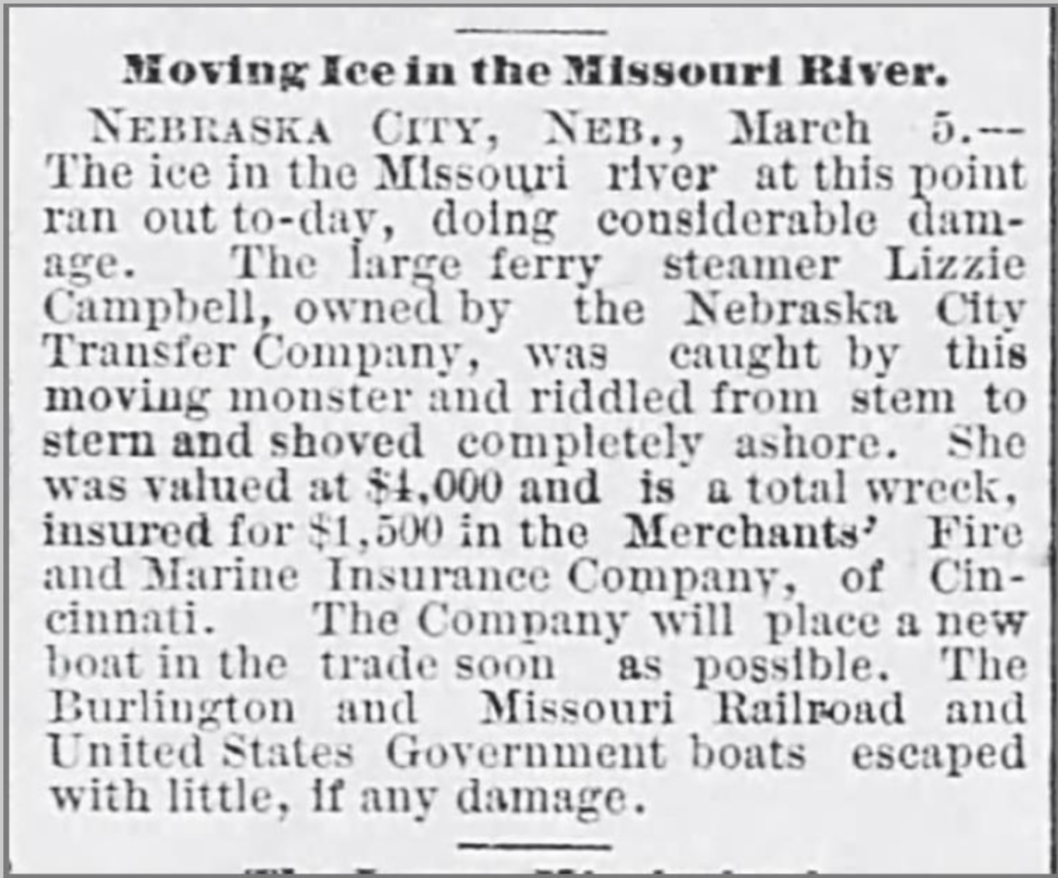
(The Decatur Herald (Decatur, Illinois) · Tue, Mar 6, 1883 · Page 1)
The boat was never salvaged and remains on the bottom of the Missouri River to this day.
